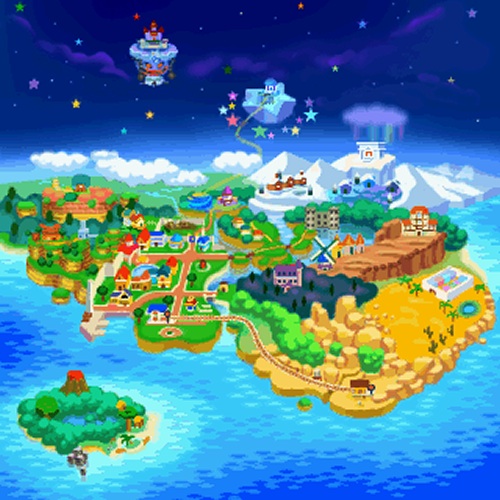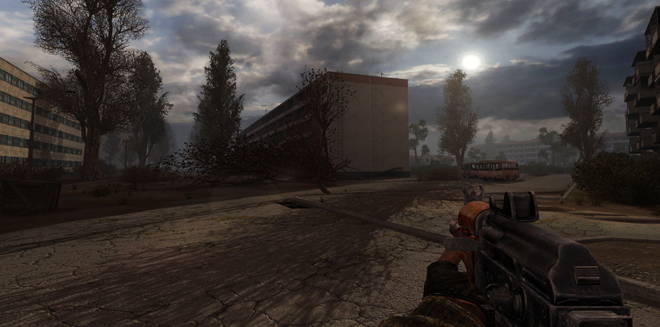This post has not been edited by the GamesBeat staff. Opinions by GamesBeat community writers do not necessarily reflect those of the staff.
This is the first entry in my series of posts about my experiences with video-game worlds. For some background, check out the introduction.
When I think of “home” — at least, as far as fictional worlds are concerned — two game worlds immediately spring to mind: Mario’s ubiquitous Mushroom World and S.T.A.L.K.E.R.’s Chernobyl Exclusion Zone.

Mushroom World
Over the course of 25 years, details pertaining to the history, mythology, inhabitants, and cultures of Mushroom World have changed wildly from Mario game to Mario game with no explanation. In fact, the land of talking mushrooms, pipe-based public transit, evil turtles, imperiled princesses, and mustachioed plumbers is probably one of the most inconsistent, amorphous game worlds in history.
Why, then, does a world that’s never consistent always feel so familiar?
The original Super Mario Bros. for the NES provided a surprisingly comprehensive template for the Mushroom World. Its instruction manual delves into details of the world that would never be seen or heard of again, remembered only by those of us old and nerdy enough.
Back in those far-gone days, Goombas were corrupted toads, traitors to the Mushroom Kingdom who sided with the evil Koopa Tribe. The Koopa, experts in black magic, transformed the non-traitorous, peace-loving toads into bricks and blocks (yes, the ones you jump on and break open for coins and hallucinogenics). Princess Toadstool, the only one with the power to reverse the transmogrifying spell, was kidnapped by the Koopa King. And Mario and Luigi…well, they just kind of wandered into things. Okay, so the plot isn’t that detailed, but it’s still the most exposition of any Mario game to date (save maybe his RPG ventures).
Over time, the diabolical conqueror King Koopa became the bumbling bully Bowser, who spawned Koopa Kids, Koopalings, and Bowser, Jr., despite the lack of a Queen Koopa. Princess Toadstool went from Mushroom Messiah to a girl who bakes a lot of cakes (seriously good cakes, well worth abducting her for). The Koopa Tribe became the Koopa Troopa and their once-touted black magic got relegated to the spell-casting Magikoopas. There have been toads and a toad named Toad, yoshis and a yoshi named Yoshi. Various races, species, enemies, and allies have come and gone with no explanation. Even The Legend of Zelda’s Octoroks somehow became Mario’s problem in Super Mario Galaxy 2.

While the details change, the broad strokes never do — just like life. On the rare occasions when I visit my parents in Connecticut, I see that the stores across the street from my old house have changed or gone out of business, but the back parking lot will always be deserted, much to the convenience of loitering neighborhood kids. I know that the Q Bridge may get wider, but it will never be finished. And even though the Branford movie theater may change hands, it will always be Hoyts in spirit.
Likewise, even though Goombas may change from mushroom traitors to vaguely mushroom-shaped blobs, they’ll always squish in the most satisfying way when I jump on them. Even tough pipes may not constitute the vast network they once did, they’ll always get me from Point A to Point B. Even though bricks and blocks may have gone from being the victims of vile Koopa sorcery to just simple bricks and blocks, I can always smash them open for sought-after goodies. And of course, all those coins, pipes, shells, bricks, and mushrooms will always produce the same, beautiful sounds.
Even though the details of the Mushroom World are never the same, I always know exactly where I am when I’m there: I’m home.
On page 2: S.T.A.L.K.E.R.'s Chernobyl Exclusion Zone.

Chernobyl Exclusion Zone
S.T.A.L.K.E.R.’s Chernobyl Exclusion Zone is about as far as you can get from the Mushroom World, both in atmosphere and design.
The Zone is bleak and cold, a ruin of modern civilization, poisoned with radiation. This diseased husk is host to flesh-eating mutants, always on the hunt for their next meal. Every step you take could be your last, whether you fall victim to a mutant, a bandit, or one of the many deadly “anomalies” that dot the landscape. Massive waves of radiation periodically scorch the atmosphere, forcing every human to duck-and-cover until the emission passes.
Like the Mushroom World, the Zone instills an overwhelming sense of familiarity, but in a very different way. The Mushroom World breeds familiarity with its charming sounds, its vibrant primary colors, and the friendly faces of Mario’s best friends and worst enemies. The Zone breeds a much more dreadful sense of familiarity, with its constant dangers and survivalist mentality. But after spending two games there and playing a third one now, it feels like all I know.

Unlike the Mushroom World, the Zone is horrifyingly consistent. After cutting my teeth on the first two games, all of the Zone’s horrors are a welcome sight. I know how to survive here, something only true locals know. I avoid walking through tall reeds, water, or anything that would make too much noise. I know which areas to avoid and when to avoid them. I know that every step I take needs to be deliberate. I know to pack light and watch my ammo. I know to make frequent trips back to camp. I know not to trust anyone. I know all of this, despite having never played a tutorial.
That knowledge — that familiarity learned through trial, death, and horror — is comforting. Knowing where the bloodsuckers lurk, where to find food or meds, how to navigate an anomaly field, is as comforting as knowing what happens when I kick a Koopa shell or when I turn my back on a Boo.
